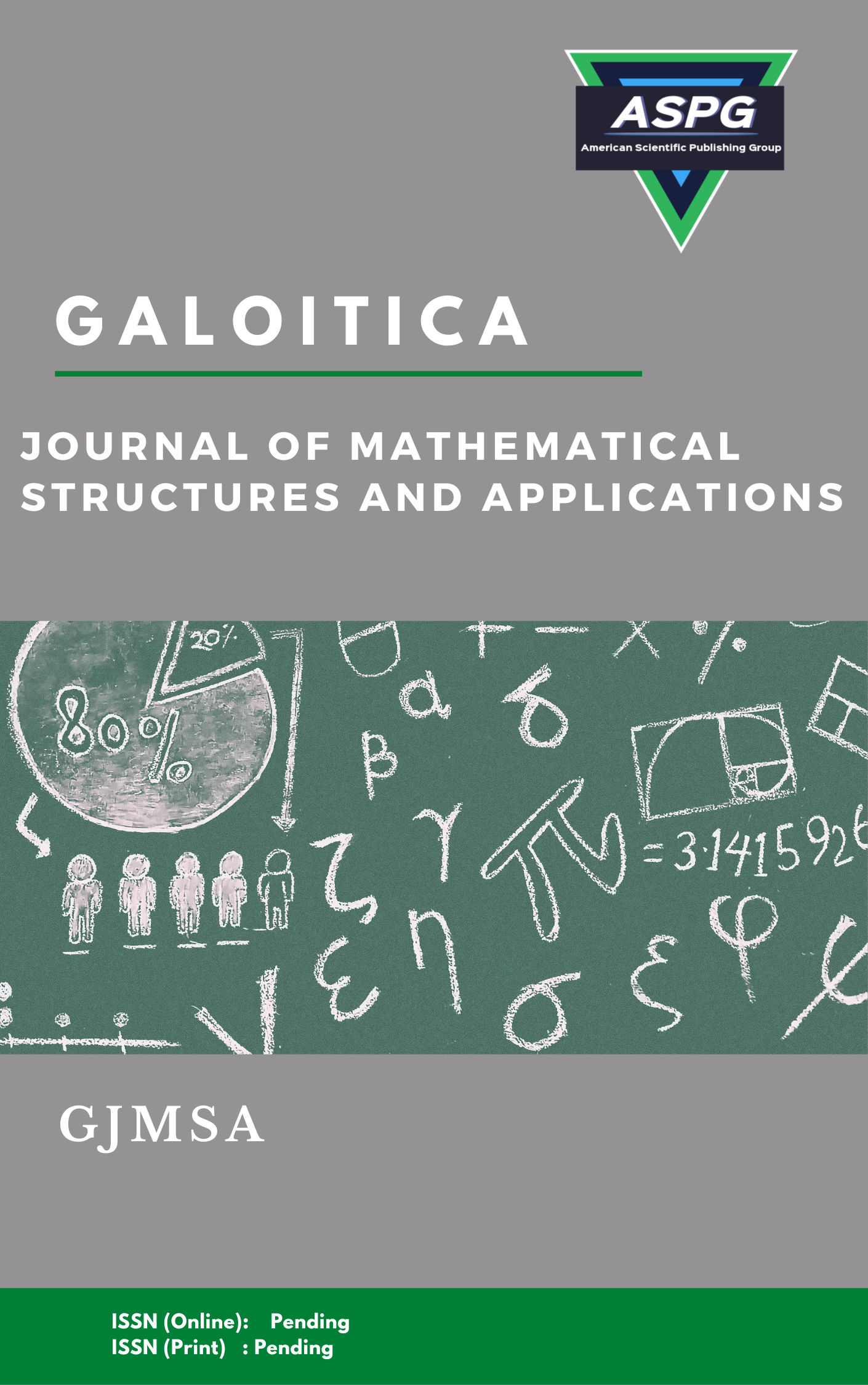

Volume 8 , Issue 1 , PP: 08-19, 2023 | Cite this article as | XML | Html | PDF | Full Length Article
Prem Kumar Singh 1 *
Doi: https://doi.org/10.54216/GJMSA.080101
Recently, many researchers paid attention towards exploration of dark data sets. In this process, a problem is addressed while characterization of dark data sets and its representation. One of the suitable examples is cricket data analysis where a match among two team’s likes India-Pakistan does not depends on win, draw or loss. There are many matches where Pakistan (or India) losses the match from any weak team in case India (or Pakistan) get out from the Tournament. These types of hidden or dark uncertainty can be represented via Human quantum Turiyam cognition in four dimensional rather than three-dimensional unconscious set. To understand these types of problems current paper tried to explore the Turiyam set with an illustrative and its distinction from other available sets.
Ambiguous , Knowledge representation , Turiyam set , Turiyam graph , Uncertainty , Unknown ,
[1]P. K. Singh, Data with Turiyam Set for Fourth Dimension Quantum Information Processing, Journal of Neutrosophic and Fuzzy Systems 1(1) (2021) 9-23. https://doi.org/10.54216/JNFS.010101
[2] P. K. Singh, Turiyam set a fourth dimension data representation. Journal of Applied Mathematics and Physics 9(7)(2021)1821-1828, doi: 10.4236/jamp.2021.97116
[3] P. K. Singh, Quaternion set for dealing fluctuation in quantum turiyam cognition. Journal of Neutrosophic and Fuzzy Systems, 4(02) (2022) 57-64, https://doi.org/10.54216/JNFS.040205
[4] P. K. Singh, Four-Way Turiyam based Characterization of Non-Euclidean Geometry, Journal of Neutrosophic and Fuzzy Systems 5(2) (2023) 69-80, doi: https://doi.org/10.54216/JNFS.050207
A. A. Basher, K. D. Ahmad, R. Ali, An Introduction to the Symbolic Turiyam Groups and AH-Substructures. Journal of Neutrosophic and Fuzzy Systems 3(02) (2022) 43-52, https://doi.org/10.54216/JNFS.030205
B. A. Basher, K.D. Ahmad, R. Ali, An Introduction to the Symbolic Turiyam Groups and AH-Substructures, Journal of Neutrosophic and Fuzzy Systems, 3(02) (2022) 43-52, https://doi.org/10.54216/JNFS.030205
[5] O. V. Shtawzen, Conjectures for Invertible Diophantine Equations Of 3-Cyclic and 4-Cyclic Refined Integers, Journal of neutrosophic and fuzzy systems 3(2022)32-36, https://doi.org/10.54216/JNFS.030203
A. Ani, M. Mashadi, S. Gemawati, Invers Moore-Penrose pada Matriks Turiyam Simbolik Real, Jambura Journal of Mathematics 5(1)(2023) 95-114, https://repository.unri.ac.id/handle/123456789/10982
[6]R. Anggraini, Ganeralizasi eneralisasi invers pada matriks Turiyam simbolik real, URI: https://repository.unri.ac.id/handle/123456789/10983
[7] G.A. Ganati, V. N. S. R. Repalle, M.A. Ashebo, Relations in the context of Turiyam sets, BMC Research Notes, 16(1) (2023) 1-6, doi: 10.1186/s13104-023-06292-4
[8] G.A. Ganati, V. N. S. R. Repalle, M.A. Ashebo, Social network analysis by Turiyam graphs. BMC Research Notes, 16(1) (2023) 1-9, https://doi.org/10.1186/s13104-023-06435-7
[9] G.A. Ganati, V. N. S. R. Repalle, M.A. Ashebo, M. Amini, Turiyam Graphs and its Applications, Information Sciences Letters 12(6)(2023)2423, doi: 10.18576/isl/120618
A. Sinclair-Desgagne, Mining for Unknown Unknowns, Available at SSRN 4426652, EPTCS 379 (2023) 507-517. https://doi.org/10.48550/arXiv.2307.05071
[10] X. Deng, C. H. Papadimitriou, Exploring an unknown graph, In: Proceedings of 31st Annual Symposium on Foundations of Computer Science, 1(1990) 355-361, doi:10.1109/FSCS.1990.89554
[11] S. Lawrence, Life, architecture, mathematics and fourth dimensions, Nexus Network Journal 17(2015) 587-604. https://doi.org/10.1007/s00004-014-0221-9
[14] Belnap J. N. (1975) A useful four-valued logic. In J. Michael Dunn and George Epstein, editors, Proceedings of the Fifth International Symposium on Multiple-Valued Logic, Modern Uses of Multiple-Valued Logic. Indiana University, D. Reidel Publishing Company, pp 8-37.
[15] S., Four-Dimensional Space, Nature 31 (1885) 481, https://doi.org/10.1038/031481a0
A. Vitória, A. Szałas, J. Małuszyński, Four-Valued Extension of Rough Sets. In: Wang, G., Li, T., Grzymala-Busse, J.W., Miao, D., Skowron, A., Yao, Y. (eds) Rough Sets and Knowledge Technology. RSKT 2008. Lecture Notes in Computer Science(), vol 5009. Springer, Berlin, Heidelberg. https://doi.org/10.1007/978-3-540-79721-0_19
[16] E. Irmak, E., Ö Kurtuldu, Concept of 4th Dimension for Databases. In: Proceedings of 2015 IEEE 14th International Conference on Machine Learning and Applications (ICMLA), Miami, FL, USA, 2015, pp. 1159-1162, doi:10.1109/ICMLA.2015.186
[17] M. S. Silva, Latest Advances on AI and Robotics Applications, Journal of Artificial Intelligence and Technology 2(4) (2022) 131http://dx.doi.org/10.37965/jait.2022.0139
[18] P. K. Singh, Four way Turiyam Set based Human Quantum Cognition Analysis, Journal of Artificial Intelligence and Technology 2(4) (2022) 144-151. https://doi.org/10.37965/jait.2022.0123
A. Said, M. Lathamaheswari, P. K. Singh, A. A. Ouallane, A Bakhouyi, A. Bakali, N. Deivanayagampillai, An Intelligent Traffic Control System Using Neutrosophic Sets, Rough sets, Graph Theory, Fuzzy sets and its Extended Approach: A Literature Review, Neutrosophic Sets Syst, 50(2022) 10-26, https://digitalrepository.unm.edu/nss_journal/vol50/iss1/2
[19] F. Smarandache, Introduction to the symbolic plithogenic algebraic structures (revisited). Neutrosophic Sets and Systems 53(1) (2023) 653-664, https://digitalrepository.unm.edu/nss_journal/vol53/iss1/39
[20] P. Singh, Ambiguous set theory: A new approach to deal with unconsciousness and ambiguousness of human perception. Journal of Neutrosophic and Fuzzy Systems, 5(1) (2023) 52-58, https://doi.org/10.54216/JNFS.050106
[21] F. Smarandache, A unifying field in logics neutrosophy: neutrosophic probability, set and logic. American Research Press, Rehoboth (1999)
[22] U. Rivieccio, Neutrosophic logics: prospects and problems, Fuzzy Sets Syst 159(14) (2008)1860–1868, https://doi.org/10.1016/j.fss.2007.11.011
[23] P. Singh, An investigation of ambiguous sets and their application to decision-making from partial order to lattice ambiguous sets. Decision Analytics Journal, 8 (2023) 100286, https://doi.org/10.1016/j.dajour.2023.100286
[24]P. K. Singh, Single-valued Plithogenic entropy measurement. Journal of Neutrosophic and Fuzzy Systems 7(1) (2023) 16-23, https://doi.org/10.54216/JNFS.070102